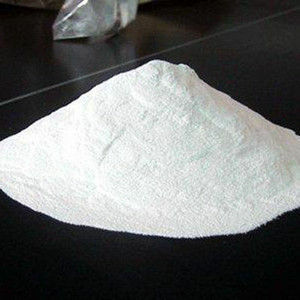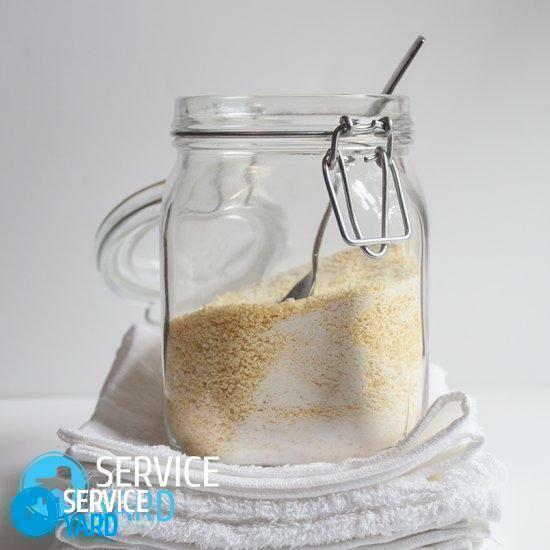
- Calcined soda: general information
- Manufacturers of soda ash
- Areas of application of soda ash
Calcined soda refers to so-called mature products, that is, products that have long existed on the market. The sources of sodium carbonate from ancient times to the early 19th century were soda lakes of Egypt, as well as some other countries, and alkaline-containing plants growing along the shores of the Mediterranean Sea and the Atlantic Ocean. Soda ash, the manufacturer of products, as well as properties and applications - these are the issues that we will consider in this article.
to content ↑Calcined soda: general information
Technical sodium carbonate is a powder or granules of white color. In the anhydrous state, calcined soda is a colorless crystalline powder and has a chemical compound Na2CO3( sodium salt of carbonic acid).
 International name for sodium carbonate: Sodium carbonate. It is this name that can be found in many producers of soda ash on the package.
International name for sodium carbonate: Sodium carbonate. It is this name that can be found in many producers of soda ash on the package.
Important! The name "soda" comes from the plant Salsona Soda. From the ashes of this plant, soda was extracted. A calcined it was called because for its production it was necessary to calcinate ash, that is, to heat up to a high temperature.
In nature, calcined soda is found in large quantities in salt formations, in the form of underground ground brines and brine in salt lakes, and also in the form of minerals.
Important! More than 60 such deposits are known on the Earth. The largest are in the US, Canada, Mexico, Kenya, South Africa. Soda lakes are also found in Transbaikalia, as well as in Western Siberia. In the United States, natural soda provides 40% of the country's demand for this mineral. In the territory of the CIS, because of the absence of large deposits, no soda from minerals is mined. Nevertheless, producers of soda ash find ways to solve the problem and supply the product to the market, focusing on the needs of consumers volume.
to content ↑Manufacturers of soda ash calcined
The problem of obtaining artificial sodium carbonate was first solved by the French pharmacist M. Leblanc. The scientist proposed to obtain soda by calcination of a mixture of sodium sulfate. From the obtained alloy, the calcined soda was leached with water, and the solution was evaporated to separate the sodium carbonate in solid form.
Important! The method of Leblanc played an important role in the development of the chemical industry. However, LeBlanc's method had significant shortcomings and huge waste. The soda residue( calcium sulphite) sometimes reached up to one and a half tons per ton of soda ash. Therefore, more rational ways of producing sodium carbonate were soon created.
In 1838, the British scientists Harrison and Hemming issued a patent for the production of sodium carbonate by the ammonia method, but on an industrial scale, a simple for laboratory conditions method was very difficult.
Methods and technologies
Currently, industrial production of soda ash is carried out in four ways:
- Ammonia( from sodium chloride).
- Natural.
- Of nifilins - based on the complex processing of nifylin raw materials.
- Carbonization of sodium hydroxide.
Depending on the scale and technologically accessible solutions, each manufacturer of soda ash selects the most optimal method of manufacturing this product.
Important! The main role in production is still played by the amiac method. Its specific gravity, which was only recently 100%, gradually began to decline. The advantages of the ammonia process include:
- Relative cheapness.
- Stability of the technological process.
- Low temperature( up to 100 С), necessary for realization of the main reactions of the process.
- High quality of the product.
- Low cost of sodium carbonate.
- Widespread prevalence.
- Availability of extraction of necessary raw materials.
Soda ash plants
The Belgian Kuye factory( built in 1865 by the Solve project) and the Likhachev Kamsko-Soda Plant( Russia) became the first world factories to use the ammonia process.
The Russian plant began its work in 1868 and was created by Colonel Ivan Likhachev on the territory of his estate of the Kazan province on the bank of the Kama River. It existed for a short time and after 4 years was closed due to unprofitable.
Production of products from natural raw materials is a relatively new industry, and it arose in the late 1940s. For today, production from natural raw materials becomes the main competitor of the ammonia process due to high ecological purity and economic profitability.
Complex processing of nifilines for calcined soda, potash, alumina and cement became the third most important method for the production of sodium carbonate. This method was developed in the USSR and is used only in Russia. This method allows you to save up to 15% of capital investment.
Important! The method of production of soda ash based on complex processing of naphylin raw materials has a number of advantages:
- Absence of waste.
- Cost-effective process.
- Complex processing of raw materials.
- Obtaining, in addition to soda products, cement and alumina.
 Carbonation of sodium hydroxide, as an industrial method of production, was developed in the late 1960's - early 1970's. Demand for soda ash was high enough, and caustic soda was in abundance. To date, this method of obtaining soda ash has lost practical significance.
Carbonation of sodium hydroxide, as an industrial method of production, was developed in the late 1960's - early 1970's. Demand for soda ash was high enough, and caustic soda was in abundance. To date, this method of obtaining soda ash has lost practical significance.
Currently, there are more than 75 soda enterprises, which are located in 34 countries. On continents, the production of soda is distributed rather unevenly:
- In Europe, 55% of the soda ash produced is produced.
- In North America - 29%.
- In South America - 1%.
- In Asia - 13%.
- In Australia - 1%.
- In Africa - 1%.
The leading producers of soda ash are:
- "ICC"( England).
- Solvei( Belgium).
- "Elaid"( USA).
- "PMK"( USA).
Domestic producers of soda ash:
- OJSC Berezniki Soda Plant( Bereznyaki), Perm Territory.
- OJSC Soda, Sterlitamak, Republic of Bashkortostan.
Applications of soda ash
Calcined soda has not only a long history of production, but also uses. It is difficult to name at least one branch of modern industry, where this product is not used. The largest consumers are the chemical, metallurgical and other industries.
Let's consider the main directions of using sodium carbonate:
- Food industry. Soda is used as a regulator of acidity.
- Leather industry. Sodium powder is used in the leather and shoe industry when producing furs for alkaline treatment of materials.
- Pulp and paper industry. Soda is used in the sizing of paper, cardboard, as well as in the production of parchment, tanning agents and mainly in the sulphite cooking of pulp.
- Manufacture of glass. Sodium carbonate of grades "A" and "B" is used in the manufacture of:
- Crystal.
- Glass blocks.
- Foam glass.
- Optical and medical glass.
- Ceramic tiles.
- Chemical industry. Sodium carbonate in the chemical industry is used to produce:
- Caustic soda.
- Sodium bicarbonate.
- Synthetic detergents( household soap, toiletry).
- Compounds of chromium, sulfites, phosphates, fluorides, sodium nitrite and sodium nitrate.
- Paint and Varnish Materials.
- Non-ferrous metallurgy. Here, calcined soda is used in the production of alumina, in the processing of lead-zinc, cobalt-nickel and tungsten-molybdenum ores.
- Petrochemical and oil refining industry. Calcined soda is used in the production of synthetic fatty acids, as well as in the processing of oil. Sodium carbonate is used, along with other components, in the drilling of oil wells to strengthen the walls of the wells, thereby preventing landslides.
- Ferrous metallurgy. Sodium carbonate is used to remove sulfur and phosphorus from pig iron, as well as to extract chemical products from resins formed during coke production.
- Mechanical Engineering. Here sodium carbonate is necessary for neutralizing the details of machines and tools. Use soda ash and to improve the technology of foundry.
- In the medical industry. Sodium carbonate is used in the manufacture of medicines.
- In the electronics industry, soda ash calcination is used to manufacture an electrovacuum glass.
- In the light industry. Calcined soda is used for washing, bleaching, dyeing fabrics, as well as producing artificial silk and nitrocellulose.
Sodium carbonate is often used for domestic use. For example:
- The product is used as a detergent.
- Soda perfectly removes fat.
- Capable of softening water when washing and boiling fabrics.
- Used for washing porcelain, faience and enamelware.
- Included in many detergent powders.
- It is used for cleaning water supplying steam boilers.
- Used as a descaling agent.
We hope that the information obtained will allow you to evaluate the merits and irreplaceable qualities of such a product as soda ash, and you will find it worthy of use.
